To keep advising our audience on food preservation techniques, both novel and historical, I thought today we could talk a bit about preserving food in wood ash.
My research suggests many food items can be successfully preserved in wood ash, including eggs, produce, and even meat.
One resource stated that the Cherokee people often stored meat in hickory ash, which served to flavor the meat and preserve it.
Farmers in Africa, meanwhile, have been preserving tomatoes in wood ash for generations.
(I’ll admit, I watched one reveal video in which a tomato preservation experiment did not work as advertised. You might want to take note of that and try another food instead if you want to try this for yourself.)
Preserving Food in Wood Ash
I’ve read that preserving food in wood ash extends the viability of the food anywhere from three months to an undetermined number of years.
Ultimately, it’s the coolness and darkness of the storage location—along with protecting the food from the air’s natural impact on organic biological processes.
Related: 8 Food Storage Myths
While most research specifically mentions using earthenware crockery for this type of preservation, I read one article that told the tale of one man who used a mere cardboard box without any negative consequence.
Another dug a hole in the ground, placed his foods in the hole, ensuring they did not touch, and then filled in the hole and the spaces around the foods with ash. (I’ll stick with the majority for my experiment, though.)
So, why should we consider storing food in wood ash when plenty of other options for preservation are available?
There are several reasons: wood ash is typically easy to come by and it is a great deterrent to pests, from mammals to insects. Moreover, wood ash (especially when the larger bits are sifted out) is very lightweight.
Ah, science. It dazzles my mind and ignites my imagination.
Today I’m going to try preserving cheese in wood ash. This will be Part One of two parts.
This part will go over the incredibly easy process of keeping cheese in wood ash, and then in three months or so, I’ll plan to do a reveal video in which we remove the cheese from the ash and give it a taste!
(I’ve also read that the ash is easy to remove from cheese and that any ash you accidentally consume will not hurt you. I’ve also read overall very positive comments about the taste of foods preserved this way. We will find out for ourselves in a few months.)
What You Will Need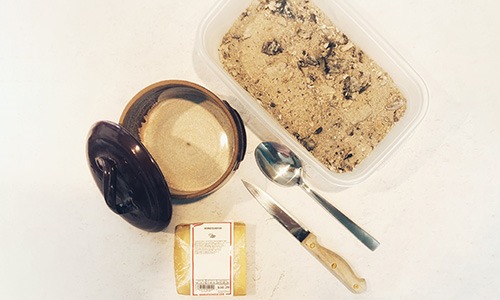
• Several cups of wood ash – I got mine from my backyard fire pit. But it’s been quite rainy here the last several weeks. So it took me a while to collect an appropriate quantity of good quality DRY ash. You may notice some larger pieces in the container. I did not use them for this project. Instead, I scooped pure ash from around the bigger bits and then threw the remaining ash and bits back into my fire pit.
• A piece of cheese – Your cheese should be about an inch thick, and in researching for this project, gruyere was mentioned numerous times, as was cheddar. I went with gruyere because it was on sale at my grocery store, and I’m less familiar with it than I am cheddar.
Related: My First Batch Of Canned Cheese
• An earthenware crock – Since I’m trying this on a small scale to start, I decided to use this small crock that I love. It has a matching lid, but if yours doesn’t, you should be able to use a plate-like our mothers and grandmothers did back in the day when they used such crocks to make pickles. It wouldn’t hurt to place a stone or brick on top of the plate if you choose that route.
• You might also want to have a knife handy and a large spoon or trowel for moving the ash to the crock.
Step 1
I wouldn’t consider this step a necessity, but I cut off a small piece of the cheese to taste.
I want to build a sensory memory of the flavor, consistency, and texture, so I have something to compare the preserved flavor to when the time comes.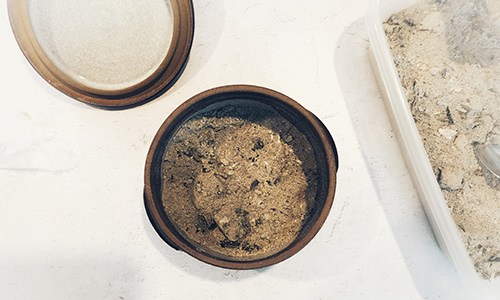
Step 2
Fill the crock with about one to two inches of ash. Tamp it down as much as possible.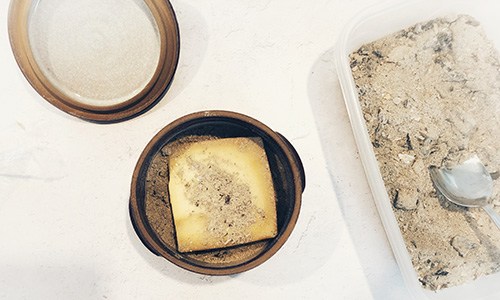
Step 3
Place your cheese on top of the tamped down ash.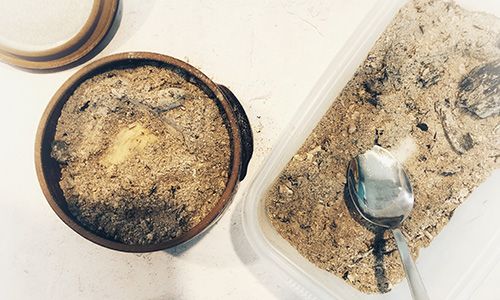
Step 4
Add more ash to fill in around the sides and over top of the cheese. You want to pack the ash completely around the cheese.
I’m also filling the crock to the very top and tamping the ash down again.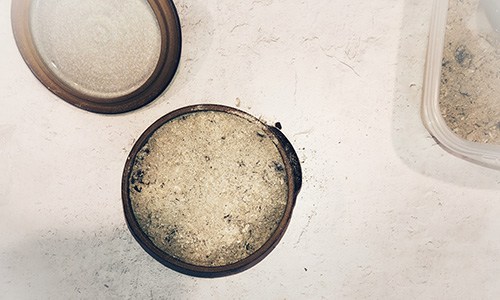
This is what mine looks like when it is filled.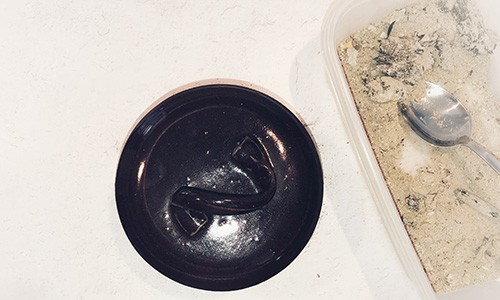
Step 5
Add your lid or plate to the filled crockery.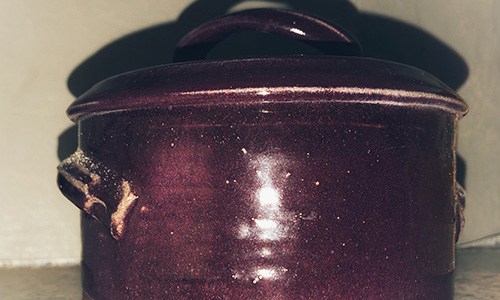
Step 6
Store in a cool, dark place. I’ve stored mine on a top shelf in the darkest, coolest part of my basement.
That, my friends, is literally all there is to it. Check back in three months for the reveal.
A Few Notes
• If the idea of having chunky ash in your preservation crock bothers you, feel free to sift your ash.
• Waxing store-bought cheese is another potential method for preservation, and maybe we will give that a try soon, too.
• This type of preservation will work ONLY with hard cheeses. Do not attempt it with soft or even medium cheeses, all of which contain too much moisture.
• Wood ash is a common material with dozens of great uses for homesteaders, preppers, gardeners, and more. It can be used as a fertilizer, ice melter, disinfectant, and more.
• The ash you use should be from hardwoods. Mine, I believe, is maple or possibly oak. You definitely want to be 100% certain there are no burned pressure-treated lumber ashes, or any plastics, or anything else potentially hazardous included in your ash mix.
Related: 30 Survival Uses for Wood Ashes You Never Thought of
The Experiment
• I’m eager to taste the cheese in a bit; I’ve read the results experienced by other food scientists, and all of them report that the cheese tastes even better preserved, saltier, grainier, and more like a fine parmesan. So, yes, I’m looking forward to that!
• I also read that using a mason jar and cubed cheese should work also. It’s always good to have options.
• While the experiment I’m working on suggests a three-month shelf life, other resources say that hard cheeses (like cheddar, gouda, gruyere, parmesan, and romano) can remain viable and edible for a decade or longer.
Final Words
All in all, if you’re curious about this type of food preservation, I say give it a try! It could not be easier, and it’s an inexpensive experiment to test.
If you’ve preserved food in wood ash in the past (or used ash for any of its myriad other benefits), we’d love to hear about it.
Leave us a comment and share your experience!
You may also like:
 Another 21 Lost Tips from 100 Years Ago – with Illustrations
Another 21 Lost Tips from 100 Years Ago – with Illustrations
What Happens If Your Pour Honey Over Meat (Video)
How To Build A Survival Debris Hut
Why You Should Think Like a Navy SEAL Instead of a Doomsday Prepper

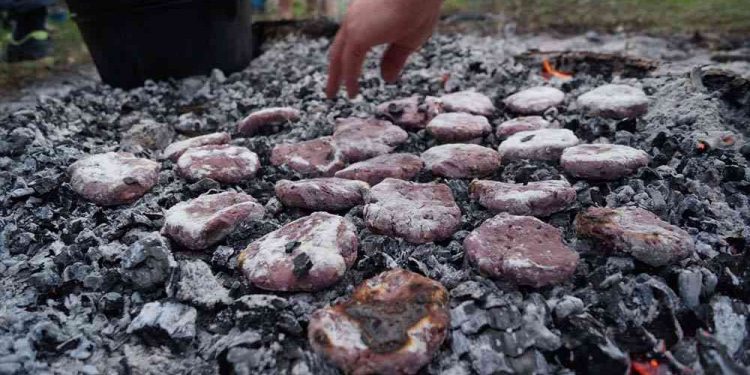













Is there a reason you can’t leave the plastic on the cheese before laying it in the ash?
My guess is the plastic would promote decay?
If you’re going to leave the cheese in its factory plastic wrap, then the purpose of covering it with something else is defeated… part of the mechanism of preserving the cheese is having its entire actual surface touching the ash. Keeping it in the plastic would allow the tiny bits of air within (including the ever-present moisture and mold spores) to eventually find a foothold. The ash is sterile and fine enough to inhibit microbial activity on the surface, which is where rot enters and begins to spread outward and inward.
I do a lot of backyard BBQ, using charcoal, which leaves a lot of ash. Could that ash be used? The bag says it is made out of hardwood.
AZ: If you are using ordinary charcoal briquettes, I believe they have clay mixed in with them and other non-wood components. I don’t know what effect those “other components” would have on this process.
If you are using EZ-Lite charcoal or whatever they are calling it these days, those briquettes have petroleum products in them to make them easy to light. I absolutely would not use ashes from those briquettes for anything calling for ash. Why not go straight to the source and just put your cheese in a jar of 10W-30?
If you are using charcoal made from pure wood, that is no different from using ash from the wood itself. Here in the PDRK, charcoal made from mesquite is quite popular. As long as it is just mesquite and not any modern world additives I would not hesitate to use mesquite charcoal ash for any ash purposes. Of course, pure wood charcoal is more expensive than modern chemically enhanced charcoal. Many people won’t even use regular briquettes for barbecuing. I would only use EZ-Lite if I just wanted a fire for whatever purpose other than cooking.
If you are using any kind of fluids to light those coals, then no you can’t uses those ashes!!
As someone directly involved in the manufacturing of charcoal briquettes and the lump charcoal as well for many years I can tell you that the match light type product contains a paraffin similar to the wax used to seal many cheeses. Not anything like 10w-30 or any other automotive lubricants. As far as additives go about 5% or so is lime and an additional amount of corn starch is used as binding agents in the briquette forms. Lump charcoal to my experience has no other additives of any kind within it.
Brent: Thanks for your input. That’s the real value of this list, the postings by folks who have real life experience as opposed to the theoretical. The president of Motel Six is reputed to have said, “The difference between school and real life is that that school teaches you a lesson and then gives ou a test. Real life gives you a test that teaches you a lesson.”
Real life sometimes extracts a higher cost for its education than even the most expensive college.
One of my real life learning experiences cost me so much money I could have gotten an MBA for half the cost and enjoyed a post-graduate cruise for wife and me to boot.
I always wondered what the accelerant was in the EZ light briquettes. Now I know due to some real life experience. I was trying to inject a little humor in the post. Obviously I am not ready for the Comedy Club circuit just yet. My act needs some more work.
As a sad matter of fact most commercial charcoal briquets these days are made of compressed coal dust unless labeled 100% hardwood. Hardwood lump charcoal is good, but the quality varies and it is not unusual to find charcoal lumps in the shape of pallet boards, and it also tends to carry a lot of sand and silt from burying the wood when it’s burned.
To further emphasize the value of old people I bet we’re about to hear a lot of food preserving tips from them.
I preserve my freshly laid chicken eggs without washing in plastic jugs covered with a solution of 1 ounce slaked lime per quart of water. Stored in a cool, dark place they last up to two years.
My wood ash is used to make lye which is either used in soap making or as part of the process of converting chicken manure to potassium nitrate.
Hi Chuck and appreciate the reply. After 55 years of life I just wish the test would ease up a little! But so seems the fate of us who wish to always learn and remember. Point being the post by Judge Holden and the use of coal. While I have no knowledge of a 100% coal briquette I do know that we put up to 10% coal in commercial products for use in restaurants to lengthen the burn times that they require. Coal was not used in the general consumer product simply because of the increased cost. Forgot about that one….. do better next time!
As a certified old grouch one of the main things that bother me is the continuing loss of quality in common American consumer products. My old Moen kitchen faucet finally got funky enough I went to Home Depot to get a replacement the other day, surprisingly I found the exact same faucet for 200.00 and was happy until I got home and opened the box to find a silly chrome plated piece of plastic junk instead of the chromed brass of the old one. It is also true that I don’t know if American chocolate is made with coal, but it sure tastes like it, good chocolate from the good old days was made with lots more real cocoa butter. Kingsford lists the main ingredients in their basic briquet as hardwood char, anthracite char, and mineral char (a byproduct of bituminous coal mining). As a skeptic and grouch I interpret that to be 30% hardwood, 29% anthracite char, and 29% mineral char. I have been grilling frequently for 55 years, about 25 years ago charcoal briquets started to shrink (Kingsford by half) and smell bad and no longer gave that great flavor to meat. Grrr, used to love those fat old Kingsford briquets with the big K molded into them…
I use something branded “Cowboy” charcoal from Fleet Farm or if I’m able to get ahold of it actual applewood or maple. Ther is a significant difference in the taste of meat and vegetables when you get away from manufactured charcol.
Brent: I don’t know a think about about 100% coal briquettes, We used to get egg coal delivered for our coal furnace when I was a kid. We used pea coal and egg coal. Apparently coal size is determined by foods???. I don’t know whether anthracite or charcoal burns hotter. My suspicion is that it is coal. I know you can burn wood in a coal stove but you can’t burn coal in a wood stove. Coal stoves if you can still find them are more expensive than wood stoves because they have to stand hotter heat. While we never used coal ash to preserve food, when I was a young lad, many decades ago, most municipal buildings in southeastern PA burned coal in the wintertime for heating purposes. That was a twofer. The coal heated the building and the ashes were spread on the road when icy and snowy for traction. The rumor at the time was that the ashes were also good for the soil. Don’t know if they were actually good for the soil but certainly better for the soil than salt. The Romans salted the fields of Carthage after they finished sacking the city. That was the Roman version of Agent Orange.
I use lemon juice, vinegar and dish soap for weed killer. I used to use a half a cup of salt in the mixture but stopped when reading about the mixture indicated that the salt would eventually make growing other plants difficult due to salt toxicity. Thinking about the Bonneville Salt Flats, there is very little growing in that salt desert. A little off topic but perhaps will contain some information of help to peppers interested in using ash to preserve food. It has been too many years ago since I was charged with cleaning out the ash pits of our two coal stoves, so I can’t compare the ashes I saw doing that chore with the ashes from a camp fire. I do know that I spread the ashes out in the yard in the area where my father maintained his vegetable garden. From that I would assume that either the ashes were good for the soil or my father bought into the rumor about them being good. We did grow sufficient veggies that my mother was kept busy canning them and we ate a lot of home canned veggies when I was a lad.
I wish I could say that with age I have stopped making mistakes. Pardon me while I rotflmao. While my mind tells me I am 20, my body is a ’37 Chevy and when I fix one part another one breaks down. While OEM parts are no longer available, there are plenty of after market parts to keep me chugging along. I am not quite the million dollar man but seem to be getting closer to that number every day. If I throw in the labor for installing the parts though, I might be well over a million dollars.
Keep learning. It keeps you alive. Got to exercise the grey matter just like the muscles, otherwise it dries up and become useless.
I think ashes are worth the experiment. We know wax works. Meats with melted fats poured over to seal out air works. Paraffin used to seal air out of jelley or jam works. Oiling egg shells works. Pickling almost anything with vinegar increases storage time exponentially. Natural fermentation such as makes beer, wine, or sourkraut or kitchen increase storage time. That can be done with many fruits, juices, or vegetables.
I especially like pickled beets. Sweet and sour. I like to use a gallon jar and start out with 1/3 jar of boiIed till tender then peeled beets, half water and half vinegar mixture to cover beets plus 2 inches. Dissolve sugar in part of the water till it suits your taste. Let it sit for a few days to pickle the beets. Next add 1 cup of raw garlic cloves and let that pickle for 4 days. Then add a 1 inch layer of peeled cut up turnip in 1/2″ thick straps, leather pickle for 4 days then add boiled eggs to pickle and gain color. Add more water and vinegar if needed to cover the eggs. Cover and refrigerate. It will be safe set out for hours at a time but keeping it cold will increase the storage time. The crisp sweet sour turnips are surprisingly good. I learned that from a Turkish neighbor. She said they pickled turnips with one beet and just a little sugar to add color. They used salt and sugar to help create natural fermentation like sourkraut because they couldn’t always buy vinegar.
Russian sourkraut is my favorite. It is layers of thin sliced cabbage that was kneeded with salt to start drawing juices, then layered with thin layers of shredded carrots. Cover with a weight to keep it moist at all times. Anything above the Liquid spoiles easily
Chuck, keep learning indeed! Welcomed advice and thank you friend.
LCC, I was reading about Japanese charcoal, very cool, any experience with it? Seems like it was their main cooking fuel for centuries and they made perfect charcoal.
Judge: Yes, when I was first in Japan 60 some years ago the average Japanese family cooked with a charcoal block called “konryo.” It was about the size of a #10 can and was the same shape as a #10 can. It had a series of holes about the size of a pencil in it running from top to bottom. The Japanese housewife used that for cooking and they also used it for heating. Many times each winter families were found dead due to carbon monoxide poisoning. The Japanese also used charcoal in hot pans that they put in the bedding to warm it up in the evening. Natural gas was only available in the center cities. We did a pretty fair job of destroying the infrastructure during WWII and ten years later a lot of it had still not been rebuilt. Charcoal braziers were everywhere. Street vendors used them to heat the food in their carts. One of my favorite pastimes was stopping at a soba cart or a roasted chestnut cart coming back from the bathhouse.
I don’t know what kind of coal the Japanese mined, but coal mining was a huge industry in Japan at that time. I don’t know if the Japanese coal was bituminous or anthracite. Anthracite burns cleaner and hotter than bituminous and remembering all the smokestacks emitting large plumes of smoke, I suspect the Japanese coal was bituminous. Once bituminous coal is coked, that is, heated as one would heat wood to make charcoal, it then will burn hotter than anthracite. Most of the coal burned in the coal-fired electric generating plants in this country is coke. It seems counterintuitive to me to heat the bituminous coal to make coke which burns more efficiently, but there are lots of things that amaze me. The charcoal making industry was also very big.
I really didn’t investigate the konryo to determine just exactly what it was composed of. It may have been made from powdered charcoal or it may have been powdered bituminous coal. It burned very cleanly and didn’t give off a lot of smoke once it was going. Usually the housewife would light it outdoors. If they lived in an apartment, each apartment had a balcony and that’s where the housewife would light the konryo. In the winter they usually used one konryo a day. The ceramic pot the charcoal was burned in is the “hibachi” that we are all familiar with. “Hi” is the Japanese word for fire. In the first couple of weeks of my Japanese language class, we used to drive the instructor crazy with calling it a “hibachi pot.” He would, with some frustration reiterate, “No, no, not hibachi potchi!!! Hibachi ! ! !” Perhaps some of the students persisted just to set him off. It seemed to particularly annoy him.
In the evenings, the Japanese family would sit around a table with the hibachi under it and a “futon” or blanket over the table. arms, legs and chests would be covered with the futon to keep warm in unheated Japanese homes. Wealthy families would have a kerosene heater that they would use to heat the room they were occupying with the rest of the house cold. Japanese life for the average family in the 1950s was spartan.
It was interesting to see how the black market changed as I remained overseas. When I first arrived cigarettes, sugar, whiskey, clothing, laundry soap were all commodities for the black market. as time went by the hot black market items became cameras, watches and other small luxury items. Then it moved to golf clubs as the golf craze hit Japan, movie cameras and more expensive luxury items including appliances. Finally it hit cars which were tricky because of registration problems. A U.S. military officer was allowed to ship his personal automobile overseas with his household goods. That didn’t apply to Marines because our regular tour was 13 months and it was considered an unaccompanied tour. No personal household goods shipped at government expense. Army, Air Force and land based Navy was a three year tour and shipment of household goods was allowed.
The U.S. officer could sell his car in Japan for more money than he originally paid for it new. It was complicated to transfer, but there were the entrepreneurs who set up businesses making the transfer for the Americans easy. By the 1960s the black market except for cigarettes and Johny Walker Black Label had pretty much dried up as the Japanese by virtue of killingly-hard, intensive work had gotten their economy back on its feet.
By the mid 60s Japanese households were cooking with natural gas piped into their homes, but still using kerosene heaters. They only heated the occupied rooms. Sitting around the kotatsu (with the hibachi under the futon) had become an artifact from the past and the intimacy of the family all together around the kotatsu was lost. The children would do their homework around the kotatsu while the parents drank tea and exchanged conversations. Perhaps dad read the newspaper. Mom might be knitting or mending clothes but they would all be together for the evening.
Nowadays dad has his study, mom is busy someplace else and the kids have their own rooms where they play video games after they finish their homework. And charcoal for the average Japanese family is now pretty much the way it is for the average American family for barbecues. Many Japanese foods are barbecued and so for the average Japanese family, they will typically eat more barbecued food than the typical U.S. family. Yakitori is barbecued chicken. Yakiniku is barbecued meat. Yakiunagi is barbecued eel, a summertime favorite. Yakisoba is noodles that have been partially barbecued. Many types of fish are barbecued as the preferred the cooking method. Although charcoal is no longer used to heat water for tea or to heat the water in the bath, without checking consumption figures, I think Japan as a country probably uses more charcoal per capita in the domestic market than the U.S., even though our barbecue grills are bigger they barbecue more. I have no idea about the industrial usage.
Hope that provides an interesting read. I might add that the Great Kanto Earthquake of 1923 was so devastating because it struck the Tokyo-Yokohama area at noontime when thousands of meals were being prepared over charcoal braziers in the Tokyo environs which resulted in the firestorms that destroyed that city rather than the earthquake itself. Much like the recent Tohoku Earthquake of 2011 where the tsunami did far more damage than the earthquake itself.
Burn your own wood to get the ash.
Not sure why they say to use hardwood ash.
Also, and charcoal in the ash is poretty valuable. You can crunch it up to pea or rice sized grains, place in a bucket with rainwater, and every morning pee in it for several weeks.
Tossing in a handful of garden dirt helps as well as a cup of Molasses.
Strain but keep any liquid.
You just made Biochar.
Mix it into the soil at 5% to 10% rate, down to the root zone of your plants.
Then you just made a rudimentary Amazonian Black Earth!
The liquid can be cut with more rainwater to make a liquid fertilizer that is bioavailable for all plants.
10 parts rain water to 1 part of the fertilizer liquid.
If you want to make biochar AND have wood ashes, you need a pyrolizer container, fill with organic matter, place in your fire.
1 hour after it stops gassing off and no vapors burning, let it cool. You just made charcoal.
It is also called ‘Cowboy Charcoal’ as well as lump charcoal.
You still have the ashes you made when making that charcoal!
Two things for the time taken to make one.
Note: Ashes from only the bark contain the most minerals.
Ashes from the heartwood have less minerals but more lignin.
I wonder WHICH ashes they recommend? From bark, heartwood, or both?
Note: I make my charcoal for biochar out of 100% oak heating pellets.
Dang near perfect size too when finished.
One bag (40 pounds) will make about 2/3 of a bag of charcoal.
Using chunks of wood instead yields lump charcoal but takes much longer to pyrolize.
Hint: Stainless steel stock pots with stainless steel lids are your friend….
FYI: if you decide to use an oily nut like pecans, they burn HOT HOT HOT for a while.
Great post, Squirrel. Thanks for the recipe. I think why hardwoods are recommended over soft woods is that many soft woods such as pine have a lot of resin in them which when used to cook food will impart a resiny taste to the food. If you have ever drunk Greek retsina you will know what I mean. It’s not exactly like what I imagine drinking turpentine would be but I think it is a close second.
This is all not too appetizing, but as my Dad use to tell us kids when we didn’t particularly like what put on the table, “if you are hungry you will eat anything!”
LCC, thanks for a well written story, I don’t have many regrets but I do wish I’d had the experience of being immersed in a fascinating culture. I remember as a kid reading a book about the Kanto quake, only the 2004 Indonesian Tsunami exceeds the great Japanese quakes. We talk about great disasters and prepare for them, pretty amazing the disasters people have faced through history. How easy do we have it?
I get my wood ash here. Stuff is ceramic grade filtered and clean.
Mrdirtfarmer.com
I got some ash here for this experiment. Mrdirtfarmer.com